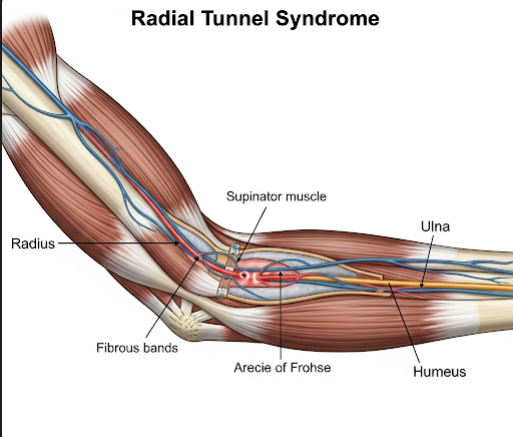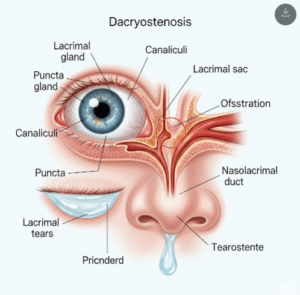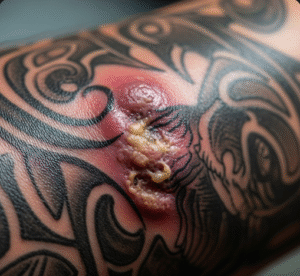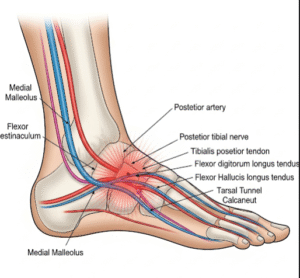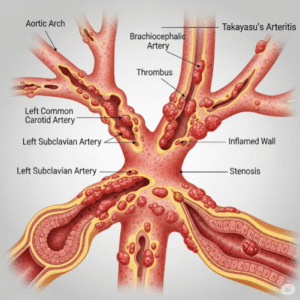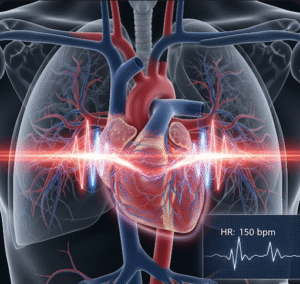Overview
Radial tunnel syndrome is a condition caused by compression or irritation of the radial nerve as it passes through the radial tunnel near the elbow. This syndrome leads to pain and weakness in the forearm and wrist and can affect daily activities. Though less common than other nerve compression syndromes, early diagnosis and treatment are important to prevent long-term damage.
What is Radial Tunnel Syndrome?
Radial tunnel syndrome occurs when the radial nerve is compressed in the area of the radial tunnel, a narrow space in the forearm. Unlike radial nerve palsy, this syndrome primarily causes pain rather than muscle weakness or numbness. It often affects people performing repetitive wrist or forearm motions.
Symptoms
Symptoms usually include:
- Dull, aching pain on the outer part of the forearm, about 3-5 cm below the elbow
- Pain that worsens with forearm activity or wrist extension
- Tenderness over the radial tunnel area
- Weakness in wrist and finger extension (in some cases)
- Absence of significant numbness or tingling
Causes
Common causes of radial tunnel syndrome include:
- Repetitive motions involving wrist and forearm (typing, sports like tennis)
- Direct trauma or injury to the forearm
- Inflammation or swelling around the radial nerve
- Anatomical variations causing nerve compression
- Overuse injuries
Risk Factors
Risk factors include:
- Repetitive or prolonged forearm and wrist activity
- Occupations or sports involving repetitive arm movements
- History of trauma or injury to the elbow or forearm
- Poor ergonomics during work or sports activities
Complications
If left untreated, radial tunnel syndrome may lead to:
- Chronic forearm pain and discomfort
- Reduced grip strength and hand function
- Nerve damage causing weakness or motor deficits
- Impact on work and daily activities
Prevention
Preventive measures include:
- Avoiding repetitive strain and overuse of the forearm muscles
- Using ergonomic tools and proper techniques during work or sports
- Regular stretching and strengthening exercises for the forearm
- Taking breaks to rest the affected arm
Treatment Options in Korea
Korea provides expert care for radial tunnel syndrome through orthopedic specialists and rehabilitation services.
1. Conservative Treatment – Rest, ice application, nonsteroidal anti-inflammatory drugs (NSAIDs), and physical therapy focusing on nerve gliding and muscle strengthening.
2. Activity Modification – Ergonomic assessment and changes to reduce repetitive strain.
3. Splinting – Wrist splints may be used to limit movement and reduce symptoms.
4. Corticosteroid Injections – Used in cases of persistent inflammation to relieve nerve irritation.
5. Surgical Decompression – In severe or refractory cases, minimally invasive surgery is performed to relieve pressure on the radial nerve.
6. Rehabilitation – Post-surgery physical therapy to restore strength and function.
7. Leading Korean Hospitals for Radial Tunnel Syndrome Treatment
- Seoul National University Hospital – Orthopedic and Neurology Departments
- Asan Medical Center – Hand and Nerve Surgery Clinic
- Samsung Medical Center – Orthopedic Surgery and Rehabilitation
- Severance Hospital – Peripheral Nerve Disorder Unit

